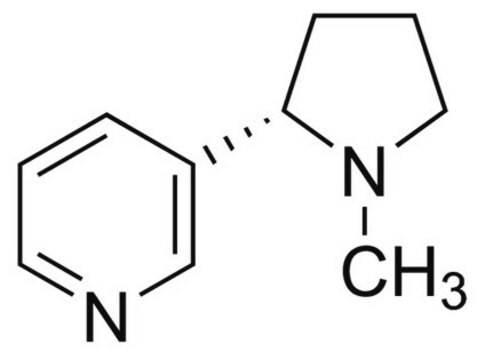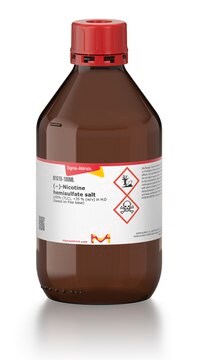About This Item
Recommended Products
Quality Level
Assay
≥99% (TLC)
form
liquid
optical activity
[α]25/D 0°(lit.)
color
yellow
solubility
ethanol: 50 mg/mL
density
1.02 g/mL at 25 °C (lit.)
SMILES string
CN1CCCC1c2cccnc2
InChI
1S/C10H14N2/c1-12-7-3-5-10(12)9-4-2-6-11-8-9/h2,4,6,8,10H,3,5,7H2,1H3
InChI key
SNICXCGAKADSCV-UHFFFAOYSA-N
Gene Information
human ... CHRNA2(1135) , CHRNA3(1136) , CHRNA4(1137)
rat ... Chrna3(25101) , Chrna4(25590) , Chrna7(25302)
Looking for similar products? Visit Product Comparison Guide
Application
- as a supplement of high-glucose Dulbecco′s modified Eagle′s medium, to test its effect on mesenchymal stem cells
- as a standard for the determination of nicotine concentration using phase high-pressure liquid chromatography
- as a test compound to study its effects on fibril formation
Biochem/physiol Actions
Packaging
Signal Word
Danger
Hazard Statements
Precautionary Statements
Hazard Classifications
Acute Tox. 2 Dermal - Acute Tox. 2 Inhalation - Acute Tox. 2 Oral - Aquatic Chronic 2 - Eye Dam. 1 - Skin Irrit. 2
Storage Class Code
6.1A - Combustible acute toxic Cat. 1 and 2 / very toxic hazardous materials
WGK
WGK 3
Flash Point(F)
213.8 °F - closed cup
Flash Point(C)
101 °C - closed cup
Personal Protective Equipment
Choose from one of the most recent versions:
Already Own This Product?
Find documentation for the products that you have recently purchased in the Document Library.
Customers Also Viewed
Our team of scientists has experience in all areas of research including Life Science, Material Science, Chemical Synthesis, Chromatography, Analytical and many others.
Contact Technical Service








